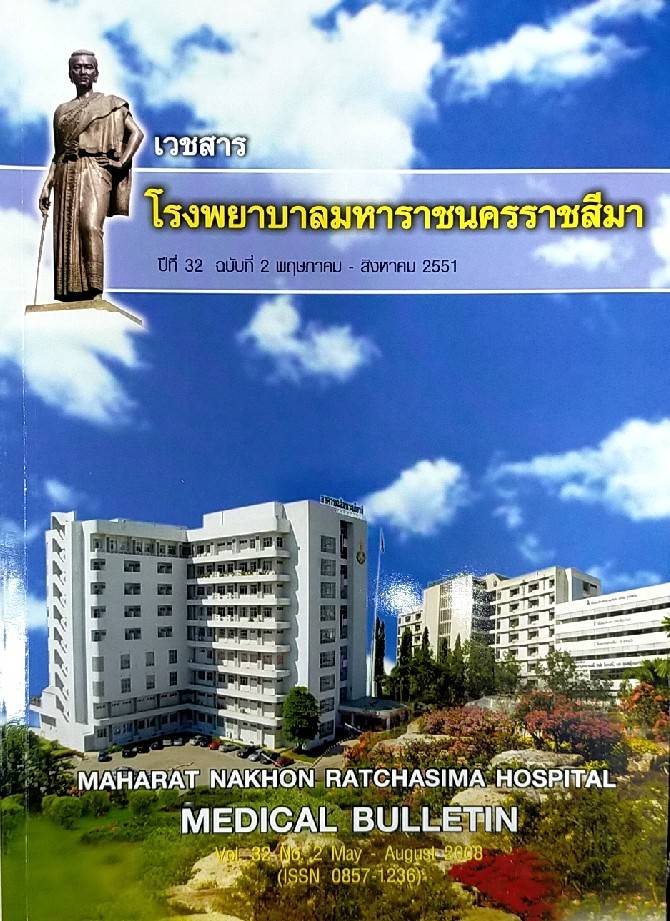รูปแบบการเสริมสร้างความเข้มแข็งของครอบครัวไทย
Main Article Content
บทคัดย่อ
การศึกษาวิจัยครั้งนี้มีวัตถุประสงค์เพื่อศึกษาอิทธิพลของปัจจัยทางจิตวิทยาที่มีต่อความเข้มแข็งของครอบครัว และศึกษารูปแบบความเข้มแข็งของครอบครัว โดยกลุ่มตัวอย่างสุ่มคัดเลือกจากสามีหรือภรรยาของครอบครัวที่อาศัยอยู่ใน7 ชุมชนของเขตบางเขน กรุงเทพมหานคร เก็บรวบรวมข้อมูลระหว่าง เดือนกรกฎาคม ถึง พฤศจิกายน 2548 วิเคราะห์ข้อมูลโดยใช้โปรแกรมคอมพิวเตอร์ สถิติที่ใช้คือ ร้อยละ ค่าเฉลี่ย+ส่วนเบี่ยงเบนมาตรฐาน และการวิเคราะห์เส้นทางความสัมพันธ์ ระหว่างตัวแปรเชิงสาเหตุกับตัวแปรตามด้วยค่าสัมประสิทธิ์อิทธิพล ผลการศึกษาพบว่า จำนวน 448 คนตัวแปรเชิงเหตุทั้งหมดสามารถอธิบายความเข้มแข็งของครอบครัวได้ร้อยละ 41 (R2 = 0.41) โดย 1) ความเครียดในครอบครัวส่งผลทางลบทั้งโดยตรงและโดยอ้อมต่อความเข้มแข็งของครอบครัวผ่านทางสุขภาพจิตของครอบครัว ความสัมพันธ์ในครอบครัว และการติดต่อสื่อสารในครอบครัว 2) สุขภาพจิตของครอบครัวส่งผลทางลบโดยอ้อมต่อความเข้มแข็งของครอบครัวผ่านทางความสัมพันธ์ในครอบครัวและการติดต่อสื่อสารในครอบครัว 3) ความสัมพันธ์ในครอบครัวส่งผลทางบวกโดยตรงต่อความเข้มแข็งของครอบครัว 4) การติดต่อสื่อสารในครอบครัวส่งผลทางบวกทั้งโดยตรงและโดยอ้อมต่อความเข้มแข็งของครอบครัวผ่านทางความสัมพันธ์ในครอบครัว 5) ค่านิยมของครอบครัวด้านบทบาททางเพศที่สังคมกำหนด ส่งผลทางบวกโดยตรงต่อความเข้มแข็งของครอบครัว ขณะที่ ค่านิยมของครอบครัวด้านบทบาทการทำงานส่งผลทางบวกทั้งโดยตรงและโดยอ้อมต่อความเข้มแข็งของครอบครัวผ่านทางความสัมพันธ์ในครอบครัวและ 6) การสนับสนุนทางสังคมของครอบครัวด้านข้อมูลข่าวสารส่งผลทางบวกโดยตรงต่อความเข้มแข็งของครอบครัวนอกจากนี้ยังพบว่าการติดต่อสื่อสารในครอบครัวเป็นปัจจัยที่มีอิทธิพลต่อความเข้มแข็งของครอบครัวมากที่สุด
Article Details

อนุญาตภายใต้เงื่อนไข Creative Commons Attribution-NonCommercial-NoDerivatives 4.0 International License.
เอกสารอ้างอิง
J. Ross Eshleman. The Family. tenth edition. Boston: Pearson Education, Inc. 2003.
Hamilton I. McCubbin and Anne I. Thompson. Family assessment inventories for research practice. Wisconsin: The University of Wisconsin-Madison. 1991.
ทิพย์วัลย์ สุรินยา. ปัจจัยที่ส่งเสริมความเข้มแข็งของครอบครัวไทย. ภาควิชาจิตวิทยา คณะสังคมศาสตร์ มหาวิทยาลัยเกษตรศาสตร์.2549.
Taro Yamane. Statistics: An introductory analysis. Tokyo: Harper International Edition. 1973.
B. Strong, C. DeVault, and B. W. Sayad. The marriage and family experience. Australia: Wadsworth; 2001.
L.A. Baxter. A dialectical perspective on communication strategies in relationship development. In S. W. Duck (ed.), Handbook of personal relationship (pp. 257-273). New York: Wiley. 1988.
Anita L. Vangelisti . Handbook of family communication. New Jersey: Lawrence Erlbaun Associates, Publishers. 2004.
Kathleen M. Galvin and Bernard J. Brommel. Family Communication: Cohesion and change. New York: Harper Collins College Publishers. 1996.
Kathlan M. Calvin, Carma L. Bylund, and Bernard J. Brommel. Family Communication: Cohesion and Change. 6th. ed. Boston: Pearson Education Inc. 2004.
S. H. Schwartz, and W. Bilsky . Toward a theory of the universal content and structure of values: Extension and cross-cultural replications. J of Per and Social Psy. 1990; 58, 878-891.
J.K. DeGenova and G.C. Kitson. Identity relevance and disruption as predictors of psychological distress for widowed and divorce women. J of Mar and the Fam 1996;58, 983-997.
J. Sprey. Family dynamics: An essay on conflict and power. In M.B. Sussman, S.K. Steinmetz, and G.W. Peterson (eds.). Handbook of Marriage and the Family (2 nd. ed., pp. 667-685) New York: Plenum Press. 1999.
B. R. Plotnik. Introduction to psychology. New York: Random House Organization Stress. 1998.
S. Cohen, and T. A. Willis. Stress, social support, and the buffering hypothesis. Psychological Bulletin. 1985; 98, 310-357.
S. Cobb. Social support and moderate of life stress. Psychosomatic Medicine. 1976; 83 :300-314.
A. S. Skolinck, and J. H. Skolinck. Family in transition. 8thed. New York: HarperCollins College Publiskers; 1994.


